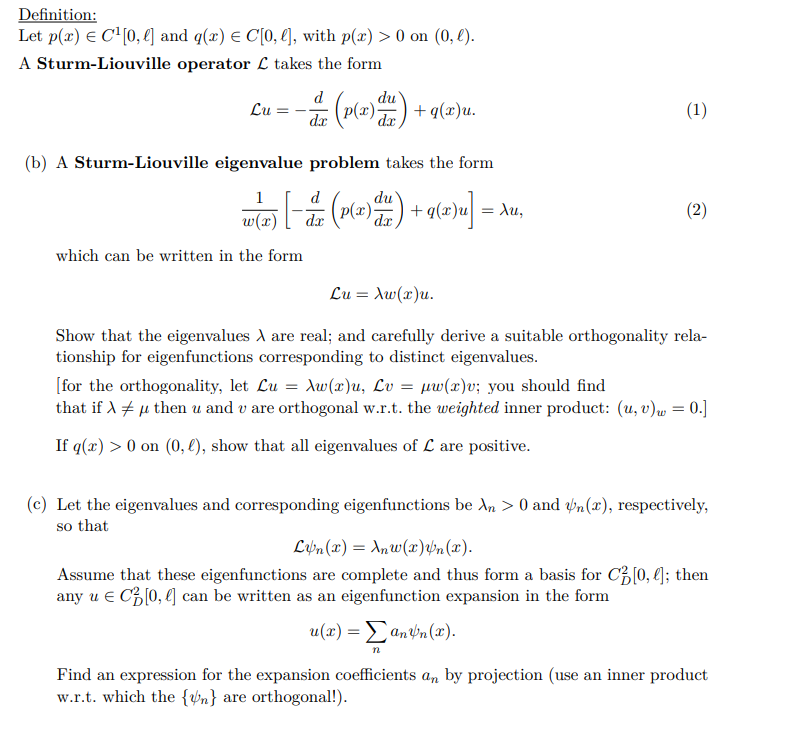
Definition: Let p(x) E C'[0, l] and qx) C[0, 1], with p(x) > 0 on (0,2). A Sturm-Liouville operator L takes the form d du Lu pa) +9(2)u. (1) (b) A Sturm-Liouville eigenvalue problem takes the form wla) [ as (pavykdant ) + 9(a)u] = du, (2) which can be written in the form Cu = Au ()u. Show that the eigenvalues are real; and carefully derive a suitable orthogonality rela- tionship for eigenfunctions corresponding to distinct eigenvalues. (for the orthogonality, let Lu = lw(x)u, Lv = uw(x)v; you should find that if 1 then u and v are orthogonal w.r.t. the weighted inner product: (u, v)w = 0.] If (2) >0 on (0,2), show that all eigenvalues of L are positive. (c) Let the eigenvalues and corresponding eigenfunctions be In > 0 and Un(x), respectively, so that Lun (2) = Anw.cun (2). Assume that these eigenfunctions are complete and thus form a basis for CB [0,4]; then any u E CB(0,4) can be written as an eigenfunction expansion in the form u(x) = anun(). Find an expression for the expansion coefficients an by projection (use an inner product w.r.t. which the {n} are orthogonal!). n Definition: Let p(x) E C'[0, l] and qx) C[0, 1], with p(x) > 0 on (0,2). A Sturm-Liouville operator L takes the form d du Lu pa) +9(2)u. (1) (b) A Sturm-Liouville eigenvalue problem takes the form wla) [ as (pavykdant ) + 9(a)u] = du, (2) which can be written in the form Cu = Au ()u. Show that the eigenvalues are real; and carefully derive a suitable orthogonality rela- tionship for eigenfunctions corresponding to distinct eigenvalues. (for the orthogonality, let Lu = lw(x)u, Lv = uw(x)v; you should find that if 1 then u and v are orthogonal w.r.t. the weighted inner product: (u, v)w = 0.] If (2) >0 on (0,2), show that all eigenvalues of L are positive. (c) Let the eigenvalues and corresponding eigenfunctions be In > 0 and Un(x), respectively, so that Lun (2) = Anw.cun (2). Assume that these eigenfunctions are complete and thus form a basis for CB [0,4]; then any u E CB(0,4) can be written as an eigenfunction expansion in the form u(x) = anun(). Find an expression for the expansion coefficients an by projection (use an inner product w.r.t. which the {n} are orthogonal!). n







